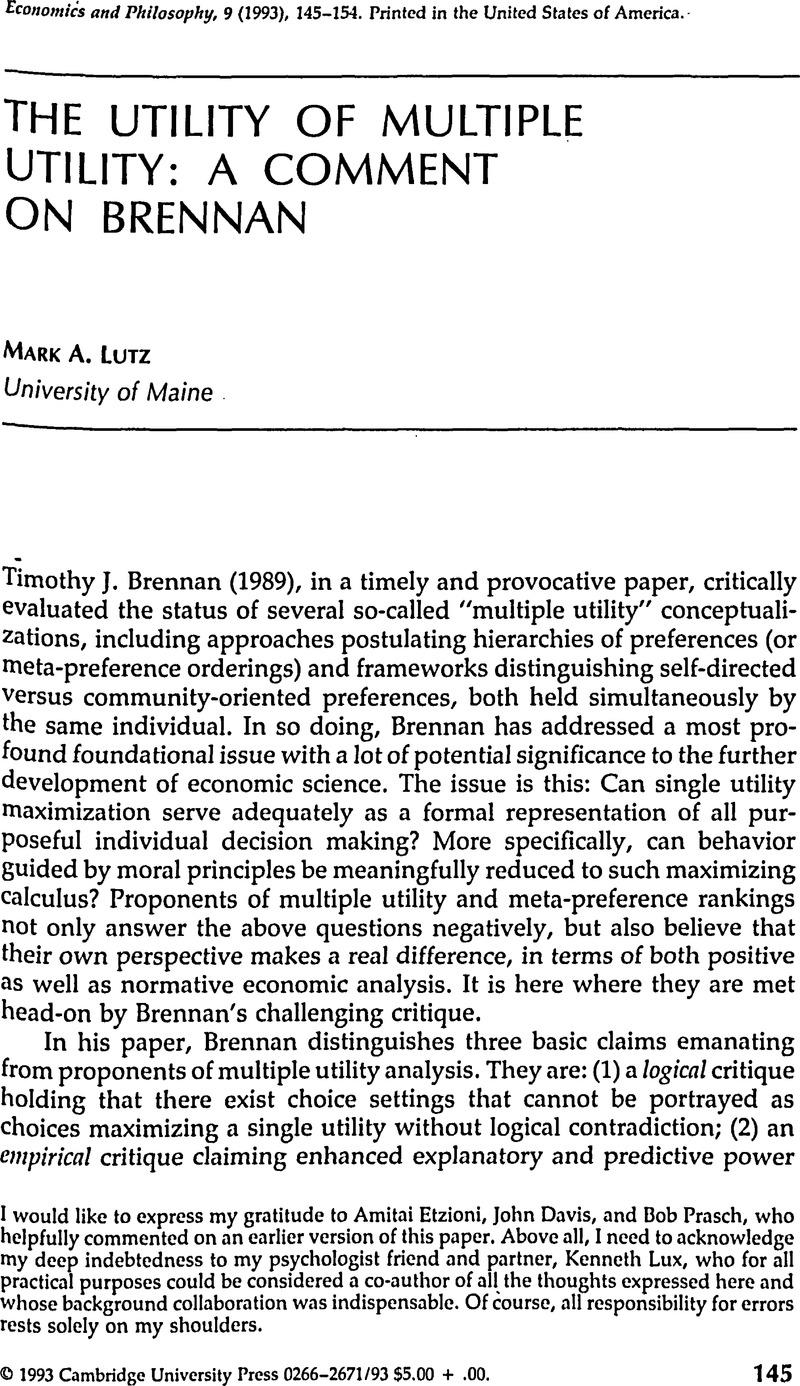Crossref Citations
This article has been cited by the following publications. This list is generated based on data provided by Crossref.
Brennan, Timothy J.
1993.
The Futility of Multiple Utility.
Economics and Philosophy,
Vol. 9,
Issue. 1,
p.
155.
Lutz, Mark A.
1993.
Cardinal Issues in the Future of Social Economics: A Humanistic View.
Review of Social Economy,
Vol. 51,
Issue. 4,
p.
455.
Lynne, Gary D.
1995.
Modifying the Neo-Classical Approach to Technology Adoption With Behavioral Science Models.
Journal of Agricultural and Applied Economics,
Vol. 27,
Issue. 1,
p.
67.
Stewart, Hamish
1995.
A Critique of Instrumental Reason in Economics.
Economics and Philosophy,
Vol. 11,
Issue. 1,
p.
57.
Meardon, Stephen J.
and
Ortmann, Andreas
1996.
SELF-COMMAND IN ADAM SMITH'S THEORY OF MORAL SENTIMENTS.
Rationality and Society,
Vol. 8,
Issue. 1,
p.
57.
Lux, Kenneth
and
Lutz, Mark
1996.
Truth, self, and feminism.
Forum for Social Economics,
Vol. 25,
Issue. 2,
p.
27.
Yee, Albert S.
1997.
Thick Rationality and the Missing "Brute Fact": The Limits of Rationalist Incorporations of Norms and Ideas.
The Journal of Politics,
Vol. 59,
Issue. 4,
p.
1001.
George, David
1997.
Working Longer Hours: Pressure from the Boss or Pressure from the Marketers?.
Review of Social Economy,
Vol. 55,
Issue. 1,
p.
33.
Mooney, Gavin
1998.
“Communitarian claims” as an ethical basis for allocating health care resources.
Social Science & Medicine,
Vol. 47,
Issue. 9,
p.
1171.
Minkler, Lanse
1999.
The Problem with Utility: Toward a Non-Consequentialist/Utility Theory Synthesis.
Review of Social Economy,
Vol. 57,
Issue. 1,
p.
4.
Casey, Frank
and
Lynne, Gary D.
1999.
Flexible Incentives for the Adoption of Environmental Technologies in Agriculture.
p.
229.
Lutz, Mark A
2000.
On the connecting of socio-economics with communitarianism ☆.
The Journal of Socio-Economics,
Vol. 29,
Issue. 4,
p.
341.
Lutz, Mark A.
2001.
Sorting the Wash.
Review of Social Economy,
Vol. 59,
Issue. 1,
p.
115.
Lux, Kenneth
2003.
The failure of the profit motive.
Ecological Economics,
Vol. 44,
Issue. 1,
p.
1.
George, David
2004.
Are Unpreferred Preferences Weak in Symbolic Content?.
Review of Social Economy,
Vol. 62,
Issue. 3,
p.
365.
White, Mark D
2004.
Can homo economicus follow Kant’s categorical imperative?.
The Journal of Socio-Economics,
Vol. 33,
Issue. 1,
p.
89.
Bianchi, Ana Maria
and
Muramatsu, Roberta
2005.
A volta de Ulisses: anotações sobre a lógica de planos e compromissos.
Revista de Economia Política,
Vol. 25,
Issue. 2,
p.
23.
Cory, Gerald A.
2006.
A behavioral model of the dual motive approach to behavioral economics and social exchange.
The Journal of Socio-Economics,
Vol. 35,
Issue. 4,
p.
592.
White, Mark D.
2006.
Multiple utilities and weakness of will: A kantian perspective.
Review of Social Economy,
Vol. 64,
Issue. 1,
p.
1.
Gezelius, Stig
2007.
Can Norms Account for Strategic Action? Information Management in Fishing as a Game of Legitimate Strategy.
Sociology,
Vol. 41,
Issue. 2,
p.
201.


